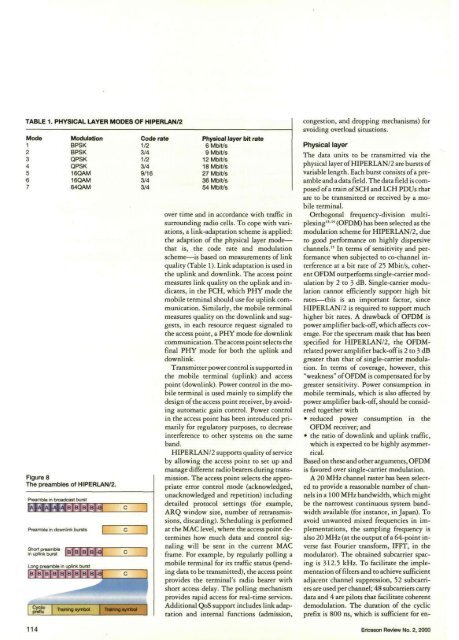ericssonhistory.com
ericssonhistory.com
ericssonhistory.com
- No tags were found...
You also want an ePaper? Increase the reach of your titles
YUMPU automatically turns print PDFs into web optimized ePapers that Google loves.
TABLE 1PHYSICAL LAYER MODES OF HIPERLAN/2Mode1234567ModulationBPSKBPSKQPSKQPSK16QAM16QAM64QAMFigure 8The preambles of HIPERLAN/2.Code rate1/23/41/23/49/163/43/4Physical layer bit rate6 Mbit/s9 Mbit/s12 MbiVs18 Mbit/s27 MbiVs Mbit/s36 MbiVs Mbit/s54 MbiVs Mbit/sover time and in accordance with traffic insurrounding radio cells. To cope with variations,a link-adaptation scheme is applied:the adaption of the physical layer mode—that is, the code rate and modulationscheme—is based on measurements of linkquality (Table 1). Link adaptation is used inthe uplink and downlink. The access pointmeasures link quality on the uplink and indicates,in the FCH, which PHY mode themobile terminal should use for uplink <strong>com</strong>munication.Similarly, the mobile terminalmeasures quality on the downlink and suggests,in each resource request signaled tothe access point, a PHY mode for downlink<strong>com</strong>munication. The access point selects thefinal PHY mode for both the uplink anddownlink.Transmitter power control is supported inthe mobile terminal (uplink) and accesspoint (downlink). Power control in the mobileterminal is used mainly to simplify thedesign of the access point receiver, by avoidingautomatic gain control. Power controlin the access point has been introduced primarilyfor regulatory purposes, to decreaseinterference to other systems on the sameband.HIPERLAN/2 supports quality of serviceby allowing the access point to set up andmanage different radio bearers during transmission.The access point selects the appropriateerror control mode (acknowledged,unacknowledged and repetition) includingdetailed protocol settings (for example,ARQ window size, number of retransmissions,discarding). Scheduling is performedat the MAC level, where the access point determineshow much data and control signalingwill be sent in the current MACframe. For example, by regularly polling amobile terminal for its traffic status (pendingdata to be transmitted), the access pointprovides the terminal's radio bearer withshort access delay. The polling mechanismprovides rapid access for real-time services.Additional QoS support includes link adaptationand internal functions (admission,congestion, and dropping mechanisms) foravoiding overload situations.Physical layerThe data units to be transmitted via thephysical layer of HIPERLAN/2 are bursts ofvariable length. Each burst consists of a preambleand a data field. The data field is <strong>com</strong>posedof a train of SCH and LCH PDUs thatare to be transmitted or received by a mobileterminal.Orthogonal frequency-division multiplexing13 - " (OFDM) has been selected as themodulation scheme for HIPERLAN/2, dueto good performance on highly dispersivechannels. 15 In terms of sensitivity and performancewhen subjected to co-channel interferenceat a bit rate of 25 Mbit/s, coherentOFDM outperforms single-carrier modulationby 2 to 3 dB. Single-carrier modulationcannot efficiently support high bitrates—this is an important factor, sinceHIPERLAN/2 is required to support muchhigher bit rates. A drawback of OFDM ispower amplifier back-off, which affects coverage.For the spectrum mask that has beenspecified for HIPERLAN/2, the OFDMrelatedpower amplifier back-off is 2 to 3 dBgreater than that of single-carrier modulation.In terms of coverage, however, this"weakness" of OFDM is <strong>com</strong>pensated for bygreater sensitivity. Power consumption inmobile terminals, which is also affected bypower amplifier back-off, should be consideredtogether with• reduced power consumption in theOFDM receiver; and• the ratio of downlink and uplink traffic,which is expected to be highly asymmetrical.Based on these and other arguments, OFDMis favored over single-carrier modulation.A 20 MHz channel raster has been selectedto provide a reasonable number of channelsin a 100 MHz bandwidth, which mightbe the narrowest continuous system bandwidthavailable (for instance, in Japan). Toavoid unwanted mixed frequencies in implementations,the sampling frequency isalso 20 MHz (at the output of a 64-point inversefast Fourier transform, IFFT, in themodulatot). The obtained subcarrier spacingis 312.5 kHz. To facilitate the implementationof filters and to achieve sufficientadjacent channel suppression, 52 subcarriersare used per channel; 48 subcarriers carrydata and 4 are pilots that facilitate coherentdemodulation. The duration of the cyclicprefix is 800 ns, which is sufficient for en-114 Ericsson Review No. 2, 2000















